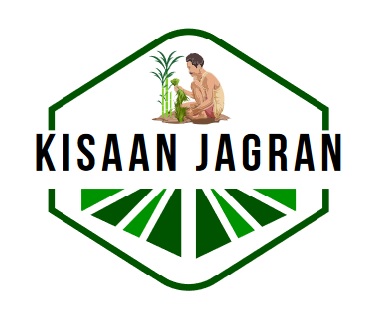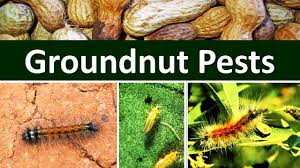
Pests of Groundnut and their Symptoms Publish Date : 01/01/2025
Pests of Groundnut and their Symptoms
Proff. R. S. Sengar and Dr. Krishanu
Groundnut (Arachis hypogea) is grown during the Kharif, Rabi, and summer seasons across various states, with Gujarat, Andhra Pradesh, Tamil Nadu, Karnataka, Rajasthan and Maharashtra being the primary producers, contributing to around 80% of the area and production. Madhya Pradesh and Odisha also cultivate groundnuts. The total cultivation area exceeds 6.16 million hectares, with an annual production of 7.17 million tonnes.
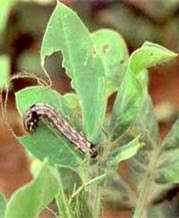
The Rabi season yields are notably higher (1600 kg/ha) compared to Kharif (1000 kg/ha) due to challenges such as rainfed cultivation and pest and disease pressures. Groundnut crops are highly sensitive to weather extremes, and their productivity is influenced by the interplay of climate conditions and pest dynamics. Climate change is expected to alter the diversity and abundance of groundnut pests, their geographical and temporal distribution, and the interactions between pests and the crop.
These changes will likely affect the efficacy of pest management practices and, consequently, food and nutritional security.
Aphids (Aphis craccivora) Symptoms: Infested plants have colonies of nymphs and adults ofv aphids. Nymphs are usually dark brown. Adults are winged or wingless with colour ranging fromv green or greenish brown to greenish black. Aphid infested plants are stunted in growth with distorted foliage and stem. Sooty mould on foliage and ant associations are also common.
Thrips (Scirtothrips dorsalis, Thrips palmi) Symptoms: Thrips are smaller insects found in folded leaflets and flowers. Adults are soft bodied and have highly fringed wings. White patches on lower surface of the leaves, and distortion of young leaflets are the symptoms due to feeding by thrips. Severe infestations cause stunted plant growth.
Jassids (Empoasca kerri, Bachlucha spp) Symptoms:
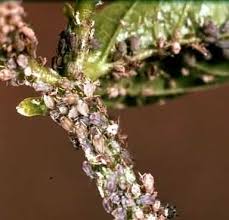
Nymphs and adults are yellowish green. Whitening of veins and presence of chlorotic patches at the tips of leaflets and necrotic leaf tips with typical ‘V’ shape are the symptoms of jassid damage. Crop presents yellow and scorched appearance known asv ‘hopper burn’ under severe infestation by jassids.
Leaf miner (Aproaerema modicella) Symptoms: Larvae are seen within mines on leaflets. Full grown larvae are green with dark head and thorax. Infestation is detected by the presence of mines that are small brown blotches on the leaf. Mines vary in size depending on the stage of larvae. At severe infestation entire leaflet becomes brown, shrivelled and dried up.
Tobacco caterpillar (Spodoptera litura) Symptoms: Eggs and gregarious larvae. The eggs are laid in cluster of several hundred on the upper surface of leaves. Egg masses appear golden brown as they are covered with the scales of moth. Young larvae are light green and larvae feed gregariously on the leaf surface, Solitary larvae. The late instar larvae are solitary and are dark green tov brown having prominent black spots on the thorax. Infested plants Scraping of the chlorophyll from the leaves is seen due to feeding by gregarious larvae. Defoliation of plant(s) occurs under heavy infestationv when solitary larvae are seen. Under severe infestation by Spodoptera, only petioles and branches of plants are left.
Red hairy caterpillar (Amsacta albistriga; A. moorei) Symptoms: Larvae have a red head with reddish brown dense hairs on the body. Anterior and posterior parts of the body of the caterpillar may have black bands encircling a red band. Caterpillars are voracious feeders and cause defoliation of the crop. Much of foliage damage is done during night time.
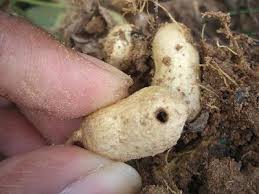
Semilooper Symptoms: The newly hatched caterpillar is yellowish green with light brown head. The fully-grown larva is dull greyish brown and larvae are slender. Larva has prominent looping movements. Jassid Adults Larvae of Leaf miner Larvae of Spodoptera Red hairy Caterpillar
Pod borer (Helicoverpa armigera) Symptoms: The larvae are dark greenish to brown in colour. Young larvae are small and found feeding on tenderv leaflets. Grown up larvae feed on flower and foliage, and defoliate the plants.
Conclusion: Groundnut cultivation in India faces significant challenges from various pests that impact crop health and productivity. Aphids cause stunted growth, distorted foliage and sooty mould, while thrips lead to leaf distortion and stunted growth. Jassids inflict characteristic ‘hopper burn,’ resulting in yellowed, scorched leaves. Leaf miners create mines on leaflets, which can cause severe leaf damage and wilting. Tobacco caterpillars, with their gregarious and solitary feeding stages, cause extensive defoliation, sometimes leaving only plant remnants.
Red hairy caterpillars and semi loopers also contribute to defoliation, with the latter exhibiting distinctive looping movement. Pod borers further exacerbate issues by damaging flowers and foliage. Effective pest management is crucial, especially as climate change potentially alters pest dynamics. Understanding and monitoring these pests' symptoms are vital for implementing targeted control strategies and ensuring sustainable groundnut production and food security.

Writer: Professor R. S. Sengar, Director Training and Placement, Sardar Vallabhbhai Patel University of Agriculture and Technology, Modipuram, Meerut.
